CCNA Option A
What is the term that is used for the area of a network that is affected when a device or network service experiences problems?
Failure domain
Collision domain
Broadcast domain
User domain
A network designer is considering whether to implement a switch block on the company network. What is the primary advantage of deploying a switch block?
A single core router provides all the routing between VLANs.
The failure of a switch block will not impact all end users.
This is a security feature that is available on all new Catalyst switches.
This is network application software that prevents the failure of a single network device.
What is the function of STP in a scalable network?
It decreases the size of the failure domain to contain the impact of failures.
It protects the edge of the enterprise network from malicious activity.
It disables redundant paths to eliminate Layer 2 loops.
It combines multiple switch trunk links to act as one logical link for increased bandwidth.
What term is used to express the thickness or height of a switch?
Rack unit
Port density
Domain size
Module size
What are two requirements when using out-of-band configuration of a Cisco IOS network device? (Choose two.)
HTTP access to the device
A terminal emulation client
Telnet or SSH access to the device
A direct connection to the console or AUX port
A connection to an operational network interface on the device
Which configuration changes will increment the configuration revision number on the VTP server?
Configuring trunk links on the VTP server
Configuring or changing the VTP password
Configuring or changing the VTP domain name
Configuring or changing the VTP version number
Configuring or deleting a VLAN or creating a VLAN name
What are three characteristics of VTP? (Choose three.)
In the default VTP mode, VLANs can be created and modified on a switch.
Switches in VTP server mode store VLANs in the vlan.dat database.
VTP-enabled switches exchange three types of advertisements: summary routes, subnet advertisements, and advertisement requests from transparent bridges.
The switch configuration must be saved and the switch reloaded to reset a configuration revision number.
VTP updates are exchanged across trunk links only.
Switches in different VTP domains can exchange updates if revision numbers are the same.
A network administrator is planning to add a new switch to the network. What should the network administrator do to ensure the new switch exchanges VTP information with the other switches in the VTP domain?
Configure the correct VTP domain name and password on the new switch.
Associate all ports of the new switch to a VLAN that is not VLAN 1.
Configure the VLANs on the new switch.
Configure all ports on the new switch to access mode.
What is the purpose of the vlan.dat file on a switch?
It holds the running configuration.
It holds the saved configuration.
It holds the VLAN database.
It holds the operating system.
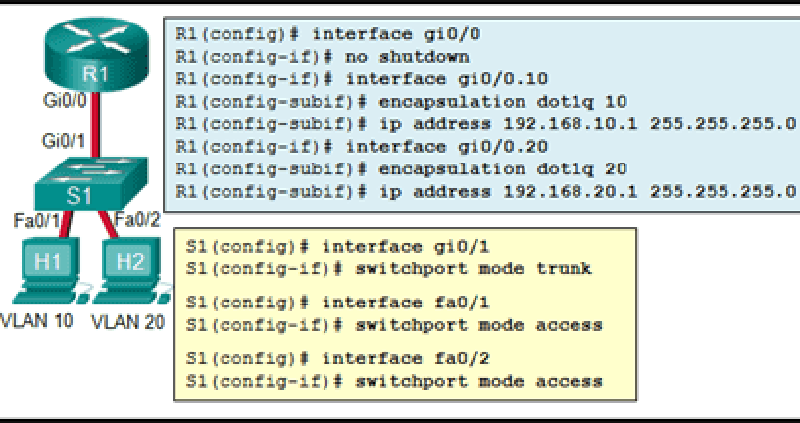
The configuration shows commands entered by a network administrator for inter-VLAN routing. However, host H1 cannot communicate with H2. Which part of the inter-VLAN configuration causes the problem?
Trunking
Port mode on the two switch FastEthernet ports
VLAN configuration
Router port configuration
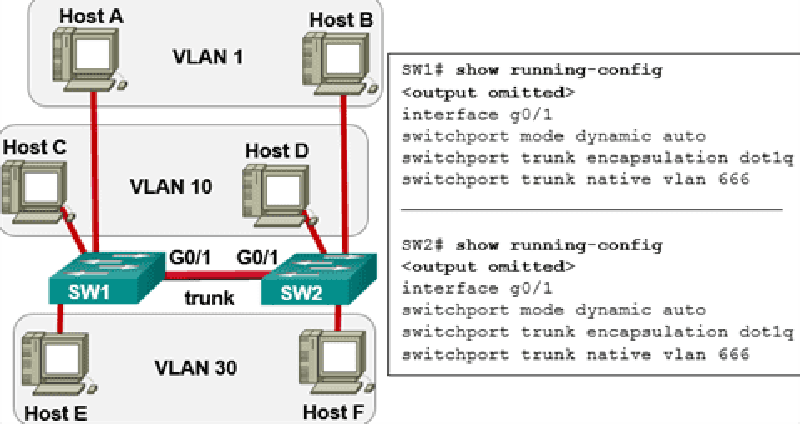
The network administrator configures both switches as displayed. However, host C is unable to ping host D and host E is unable to ping host F. What action should the administrator take to enable this communication?
Include a router in the topology.
Associate hosts A and B with VLAN 10 instead of VLAN 1.
Remove the native VLAN from the trunk.
Configure either trunk port in the dynamic desirable mode.
Add the switchport nonegotiate command to the configuration of SW2.
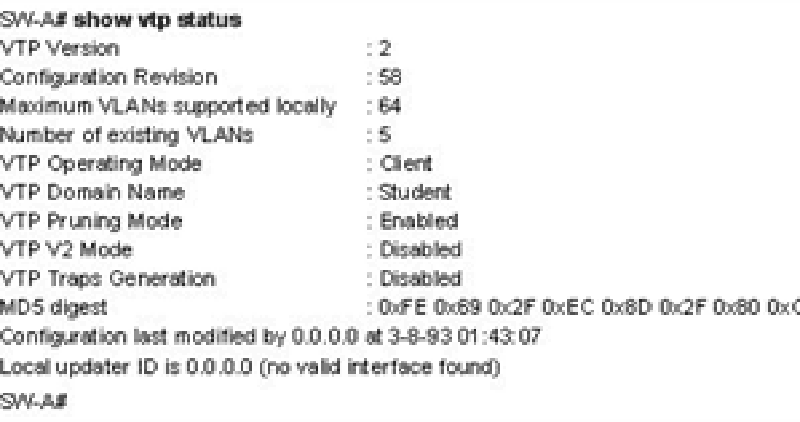
Switch SW-A is to be used as a temporary replacement for another switch in the VTP Student domain. What two pieces of information are indicated from the exhibited output? (Choose two.)
The other switches in the domain can be running either VTP version 1 or 2.
There is a risk that the switch may cause incorrect VLAN information to be sent through the domain.
VTP will block frame forwarding on at least one redundant trunk port that is configured on this switch.
VLAN configuration changes made on this switch will be sent to other devices in the VTP domain.
This switch will update its VLAN configuration when VLAN changes are made on a VTP server in the same domain.
What eliminates switching loops?
Hold-down timers
Poison reverse
Spanning Tree Protocol
Time to Live
VTP
A small company network has six interconnected Layer 2 switches. Currently all switches are using the default bridge priority value. Which value can be used to configure the bridge priority of one of the switches to ensure that it becomes the root bridge in this design?
1
28672
32768
34816
61440
What is the value used to determine which port on a non-root bridge will become a root port in a STP network?
The highest MAC address of all the ports in the switch
The lowest MAC address of all the ports in the switch
The VTP revision number
The path cost
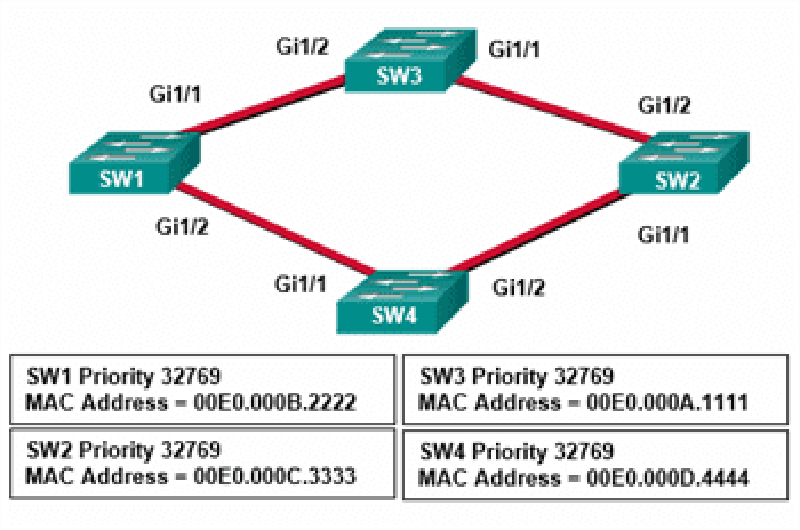
Which switch will be elected the root bridge and which switch will place a port in blocking mode? (Choose two.)
SW1 will become the root bridge.
SW2 will become the root bridge.
SW2 will get a port blocked.
SW4 will get a port blocked.
SW3 will become the root bridge.
SW4 will become the root bridge.
Which three STP states were replaced with the RSTP discarding state? (Choose three.)
Listening
Learning
Blocking
Disabled
Forwarding
A network administrator enters the spanning-tree portfast bpduguard default command. What is the result of this command being issued on a Cisco switch?
Any switch port will be error-disabled if it receives a BPDU.
Any trunk ports will be allowed to connect to the network immediately, rather than waiting to converge.
Any switch port that has been configured with PortFast will be error-disabled if it receives a BPDU.
Any switch port that receives a BPDU will ignore the BPDU message.
As the network administrator you have been asked to implement EtherChannel on the corporate network. What does this configuration consist of?
Providing redundant links that dynamically block or forward traffic
Grouping multiple physical ports to increase bandwidth between two switches
Grouping two devices to share a virtual IP address
Providing redundant devices to allow traffic to flow in the event of device failure
A network administrator configured an EtherChannel link with three interfaces between two switches. What is the result if one of the three interfaces is down?
The EtherChannel fails.
The remaining two interfaces continue to load balance traffic.
The remaining two interfaces become separate links between the two switches.
One interface becomes an active link for data traffic and the other becomes a backup link.
When EtherChannel is configured, which mode will force an interface into a port channel without exchanging aggregation protocol packets?
Active
Auto
On
Desirable

A network administrator is reviewing the configuration of switch S1. Which protocol has been implemented to group multiple physical ports into one logical link?
PAgP
DTP
LACP
STP
A network administrator is analyzing the features that are supported by different first-hop router redundancy protocols. Which statement describes a feature that is associated with HSRP?
HSRP uses active and standby routers.
It uses ICMP messages in order to assign the default gateway to hosts.
It allows load balancing between a group of redundant routers.
HSRP is nonproprietary.
What is the term used to describe a network topology where the subnets from a major classful network address space are separated from each other by addresses from a different major classful network address?
Multihomed network
Converged network
Discontiguous network
Data network
What type of packets are sent when there is a change in the EIGRP topology?
Hello
Triggered bounded update
Acknowledge
Reply
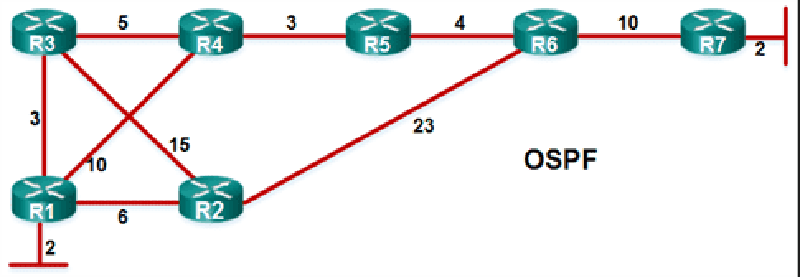
A network administrator has configured OFPF in the topology as shown. What is the preferred path to get from the LAN network that is connected to R1 to the LAN network that is connected to R7?
R1-R3-R4-R5-R6-R7
R1-R3-R2-R6-R7
R1-R2-R6-R7
R1-R4-R5-R6-R7
What does the SPF algorithm consider to be the best path to a network?
The path with the least number of hops.
The path with the smallest delays.
The path that includes the fastest cumulative bandwidth links.
The path that includes the fastest single bandwidth link.
Which three pieces of information does a link-state routing protocol use initially as link-state information for locally connected links? (Choose three.)
The link router interface IP address and subnet mask
The type of network link
The link next-hop IP address
The link bandwidth
The cost of that link
What indicates to a link-state router that a neighbor is unreachable?
If the router no longer receives routing updates
If the router no longer receives hello packets
If the router receives an update with a hop count of 16
If the router receives an LSP with previously learned information
What are three features of EIGRP? (Choose three.)
Uses the Shortest Path First algorithm
Establishes neighbor adjacencies
Uses the Reliable Transport Protocol
Sends full routing table updates periodically
Broadcasts updates to all EIGRP routers
Supports equal and unequal cost load balancing
What capability do protocol-dependent modules provide to the EIGRP routing protocol?
Route different Layer 3 protocols
Exchange summary routes between areas
Combine routes learned from different protocols into a single routing table
Load balance between routing protocols
When are EIGRP update packets sent?
Only when necessary
When learned routes age out
Every 5 seconds via multicast
Every 30 seconds via broadcast

Which command should be used to configure EIGRP to only advertise the network that is attached to the gigabit Ethernet 0/1 interface?
Network 172.16.23.64 0.0.0.63
Network 172.16.23.0 255.255.255.192
Network 172.16.23.64 0.0.0.127
Network 172.16.23.0 255.255.255.128
Which statement describes the autonomous system number used in EIGRP configuration on a Cisco router?
It carries the geographical information of the organization.
It functions as a process ID in the operation of the router.
It is a globally unique autonomous system number that is assigned by IANA.
It identifies the ISP that provides the connection to network of the organization.
Which two parameters does EIGRP use by default to calculate the best path? (Choose two.)
Delay
MTU
Reliability
Transmit and receive load
Bandwidth
An EIGRP router loses the route to a network. Its topology table contains two feasible successors to the same network. What action will the router take?
The DUAL algorithm is recomputed to find an alternate route.
The router uses the default route.
The best alternative backup route is immediately inserted into the routing table.
The router will query neighbors for an alternate route.
When will a router that is running EIGRP put a destination network in the active state?
When the EIGRP domain is converged
When there is outgoing traffic toward the destination network
When there is an EIGRP message from the successor of the destination network
When the connection to the successor of the destination network fails and there is no feasible successor available
Which address is used by an IPv6 EIGRP router as the source for hello messages?
The 32-bit router ID
The IPv6 global unicast address that is configured on the interface
The all-EIGRP-routers multicast address
The interface IPv6 link-local address
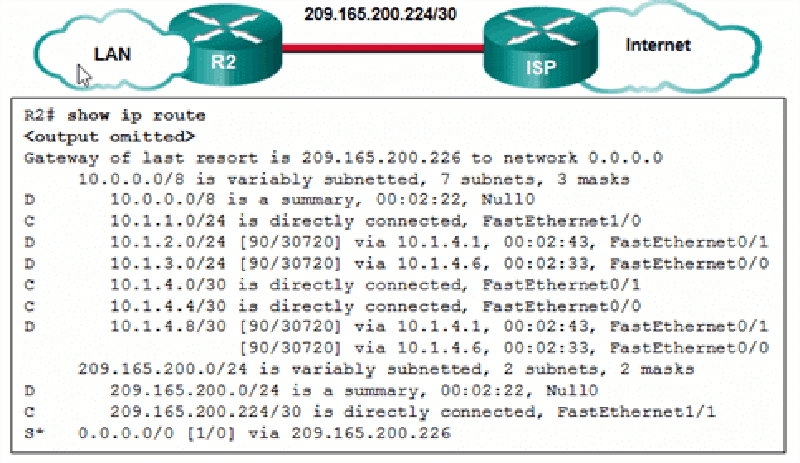
Which route or routes will be advertised to the router ISP if autosummarization is enabled?
10.0.0.0/8
10.1.0.0/16
10.1.0.0/28
10.1.1.0/24 10.1.2.0/24 10.1.3.0/24 10.1.4.0/28
Which command will configure an IPv6 default static route?
Router(config)# ipv6 ::/64 s0/0/0
Router(config-rtr)# redistribute static
Router(config)# ipv6 route ::/0 s0/0/0
Router(config)# ipv6 unicast-routing
Which statement describes the load balancing behavior of EIGRP?
EIGRP for IPv4 supports unequal cost load balancing, but EIGRP for IPv6 does not.
EIGRP for IPv6 supports unequal cost load balancing, but EIGRP for IPv4 does not.
Neither EIGRP for IPv4 nor EIGRP for IPv6 support unequal cost load balancing.
Both EIGRP for IPv4 and EIGRP for IPv6 support unequal cost load balancing.
What routing protocol can be configured to load balance across paths with unequal metrics through the use of the variance command?
EIGRP
OSPF
OSPFv3
RIPng
What are two features of a link-state routing protocol? (Choose two.)
Routers send periodic updates only to neighboring routers.
Routers send triggered updates in response to a change.
Routers create a topology of the network by using information from other routers.
The database information for each router is obtained from the same source.
Paths are chosen based on the lowest number of hops to the designated router.
A router is participating in an OSPFv2 domain. What will always happen if the dead interval expires before the router receives a hello packet from an adjacent DROTHER OSPF router?
OSPF will run a new DR/BDR election.
SPF will run and determine which neighbor router is “down”.
A new dead interval timer of 4 times the hello interval will start.
OSPF will remove that neighbor from the router link-state database.
In an OSPFv2 configuration, what is the effect of entering the command network 192.168.1.1 0.0.0.0 area 0?
It changes the router ID of the router to 192.168.1.1.
It enables OSPF on all interfaces on the router.
It tells the router which interface to turn on for the OSPF routing process.
It allows all 192.168.1.0 networks to be advertised.
What does the cost of an OSPF link indicate?
A higher cost for an OSPF link indicates a faster path to the destination.
Link cost indicates a proportion of the accumulated value of the route to the destination.
Cost equals bandwidth.
A lower cost indicates a better path to the destination than a higher cost does.
Which two addresses represent valid destination addresses for an OSPFv3 message? (Choose two.)
FF02::5
224.0.0.5
FF02::A
FE80::42
2001:db8:acad:1::1
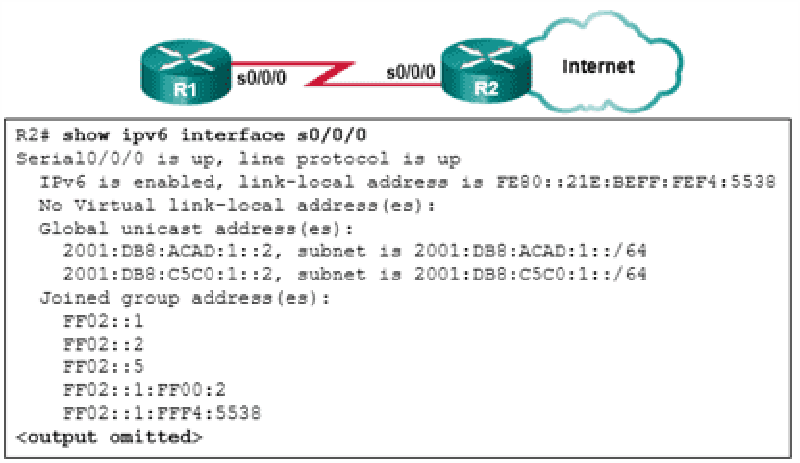
R1 and R2 are OSPFv3 neighbors. Which address would R1 use as the next hop for packets that are destined for the Internet?
FF02::5
2001:DB8:ACAD:1::2
2001:DB8:ACAD:1::2
2001:DB8:ACAD:1::2
What information is contained in OSPF type 3 LSAs?
Networks reachable in other areas
Networks learned from other routing protocols
The router ID of the DR to all routers in the area
The router ID of an ASBR and the route to reach it

A company has migrated from single area OSPF to multiarea. However, none of the users from network 192.168.1.0/24 in the new area can be reached by anyone in the Branch1 office. From the output in the exhibit, what is the problem?
There are no interarea routes in the routing table for network 192.168.1.0.
The OSPF routing process is inactive.
The link to the new area is down.
The router has not established any adjacencies with other OSPF routers.
{"name":"CCNA Option A", "url":"https://www.quiz-maker.com/QPREVIEW","txt":"What is the term that is used for the area of a network that is affected when a device or network service experiences problems?, A network designer is considering whether to implement a switch block on the company network. What is the primary advantage of deploying a switch block?, What is the function of STP in a scalable network?","img":"https://cdn.poll-maker.com/21-826305/xckds.png?sz=1200-00141000000940605300"}
More Quizzes
Economia1
502530
Quiz of Rob
1586
ABP Quiz 1
10510
Injectables Quiz
14714
Androgynous Face Test - Masculine or Feminine?
201017526
Nerd or Geek - Dork or Normal? Find Your Type
201017330
Atmosphere Trivia - Test Your Earth Science Knowledge
201019448
Free Personality Disorders Test - Instant Results
201018692
Which Justice League Member Are You? Personality
201019018
Stupid Maths Questions - Free Brain Teaser Challenge
201016894
Taoism History - Test Your Knowledge
201017330
Matching - Free Interactive Practice Online
201016544